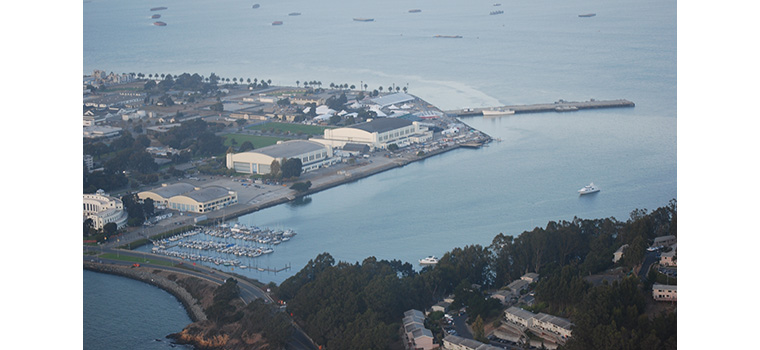What are the strongest winds you're ever been out in? It's one of the most frequently asked questions new students have for a sailing instructor

Clipper Cove, the body of water between Treasure and Yerba Buena Islands, is protected from weather coming from the south by Yerba Buena Island. Photo by Joel Williams
BY CAPTAIN RAY
Published: July, 2018
What are the strongest winds you’re ever been out in? It’s one of the most frequently asked questions new students have for a sailing instructor. For me, my strongest wind experience happened about 15 years ago, and it happened right here on San Francisco Bay.
I was conducting a U.S. Sailing Association Cruising Instructor evaluation. This is a three-day, live-aboard course during which the Instructor Candidates are required to perform a variety of tasks to demonstrate the qualifications to teach U.S. Sailing courses. We had been out on the Bay, just north of Treasure Island, doing night overboard rescues. It was about 2200 (10 p.m.) and time to end this drill. The plan was to anchor for the night in Clipper Cove—the body of water between Treasure and Yerba Buena Islands.
The forecast was for unsettled weather, with a front passing through the area overnight. This would cause the normal westerly wind—coming in the Golden Gate—to switch to the southwest. The wind was also predicted to increase in strength, gusting as high as 35 knots. All of this was to be accompanied by rain, heavy at times.
As we completed the overboard rescue operations and headed for Clipper Cove, my gut kept telling me, “This is not a night to be anchored out!” However, I was only one of three U.S. Sailing Instructor Trainers running this course. The other two (each on a separate boat) were people whose opinions I valued and respected. Not wanting to be viewed as a wimp, I didn’t raise my concerns. After all, it was only blowing five to eight knots at that point and Yerba Buena Island protects Clipper Cove reasonably well from southwest winds. What could go awry?
And so, all three boats anchored in Clipper Cove. As a precaution, an anchor watch was set on each boat. This means that all crew members take turns staying awake in 90-minute shifts through the night—just in case. I took the first watch and by the time it was over, it was raining moderately and blowing 20-25 knots from the southwest. For the rest of the night as the conditions worsened, I lay awake in my berth with my foul-weather gear and boots on, awaiting word that something was amiss.
All night I waited, and nothing happened. Yes, the wind blew harder and harder, certainly more that the predicted 35 knots, and the rain was heavy at times. However, the anchor held all through the night. It wasn’t until just after the sun had risen (when everything always feels better!) that the strongest gusts of the storm swept around and over Yerba Buena Island and ripped our anchor free of the bottom. Suddenly, we were underway and headed rapidly toward the old Navy pier at the southeast corner of Treasure Island.
I took the helm and steered the boat through the narrow space between the pier to port (our left side) and the shallows to starboard (our right side). At the same time, we had to avoid being struck by flying dinghies that were being blown off their storage racks on Treasure Island. Driven by this astonishing wind, five or six of these 100-pound boats were bouncing and tumbling across the surface of the Bay, heading toward Emeryville. Meanwhile, my crew worked hard to recover the anchor and over 150 feet of chain and line that were dragging in the water off the bow. Until the anchor and lines were back on board we dared not start the motor for fear of wrapping it all in the propeller. With the anchor recovered, the engine started, all the flying dinghies dodged, and a bit of open water to maneuver in, the immediate pressures eased.
Going anywhere upwind in that blow would have been very uncomfortable and incredibly difficult, if not impossible. Besides, I had no desire to go back into Clipper Cove and reanchor in those conditions. That meant we were heading to leeward (downwind). In that direction there were five options available to us: the two marinas in Richmond (Brickyard Cove and Marina Bay), the two marinas in Emeryville (Emery Cove and the Emeryville Marina), and the Berkeley Marina. I’d been in all of them, but was most familiar with Berkeley, so the decision was easy. Berkeley, here we come!
This saga will continue next month…
Ray Wichmann is a US SAILING-certified Ocean Passagemaking Instructor, a US SAILING Master Instructor Trainer, and a member of US SAILING’s National Faculty. He holds a 100-Ton Master’s License, was a charter skipper in Hawai’i for 15 years, and has sailed on both coasts of the United States, in Mexico, the Caribbean and Greece. He is presently employed as the Master Instructor at OCSC Sailing in the Berkeley Marina.

